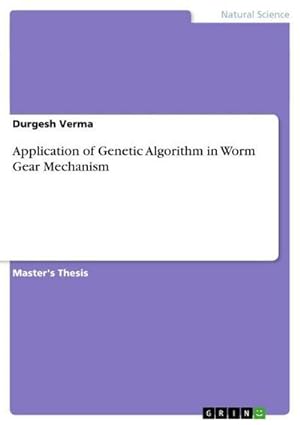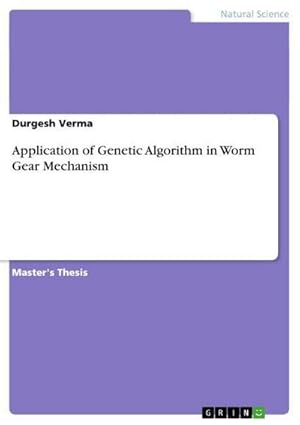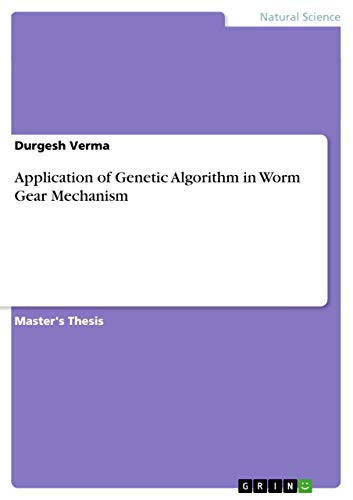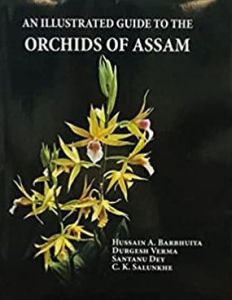Durgesh Verma (5 results)
Product Type
- All Product Types
- Books (5)
- Magazines & Periodicals
- Comics
- Sheet Music
- Art, Prints & Posters
- Photographs
- Maps
- Manuscripts & Paper Collectibles
Condition
Binding
Collectible Attributes
- First Edition (1)
- Signed
- Dust Jacket
- Seller-Supplied Images (3)
- Not Print on Demand (4)
Free Shipping
- Free US Shipping
Seller Location
Seller Rating
-
Application of Genetic Algorithm in Worm Gear Mechanism
Published by GRIN Verlag Feb 2013, 2013
ISBN 10: 3656359555ISBN 13: 9783656359555
Seller: BuchWeltWeit Ludwig Meier e.K., Bergisch Gladbach, Germany
Book Print on Demand
Taschenbuch. Condition: Neu. This item is printed on demand - it takes 3-4 days longer - Neuware -Master's Thesis from the year 2010 in the subject Mathematics - Applied Mathematics, grade: 85%, Priyadarshini College of Engineering, Nagpur, course: M-TECH., language: English, abstract: In this study, a foundation and solution technique using Genetic Algorithm (GA) for design optimization of worm gear mechanism is presented for the minimization of power-loss of worm gear mechanism with respect to specified set of constraints.Number of gear tooth and helix (thread) angle of worm are used as design variables and linear pressure, bending strength of tooth and deformation of worm are set as constraints.The GA in Non-Traditional method is useful and applicable for optimization of mechanical component design. The GA is an efficient search method which is inspired from natural genetics selection process to explore a given search space.In this work, GA is applied to minimize the power loss of worm gear which is subjected to constraints linear pressure, bending strength of tooth and deformation of worm.Up to now, many numerical optimization algorithms such as GA, Simulated Annealing, Ant-Colony Optimization, Neural Network have been developed and used for design optimization of engineering problems to find optimum design. Solving engineering problems can be complex and a time consuming process when there are large numbers of design variables and constraints. Hence, there is a need for more efficient and reliable algorithms that solve such problems. The improvement of faster computer has given chance for more robust and efficient optimization methods. Genetic algorithm is one of these methods. The genetic algorithm is a search technique based on the idea of natural selection and genetics. 64 pp. Englisch.
-
Application of Genetic Algorithm in Worm Gear Mechanism
Published by GRIN Verlag, 2013
ISBN 10: 3656359555ISBN 13: 9783656359555
Seller: AHA-BUCH GmbH, Einbeck, Germany
Book
Taschenbuch. Condition: Neu. Druck auf Anfrage Neuware - Printed after ordering - Master's Thesis from the year 2010 in the subject Mathematics - Applied Mathematics, grade: 85%, Priyadarshini College of Engineering, Nagpur, course: M-TECH., language: English, abstract: In this study, a foundation and solution technique using Genetic Algorithm (GA) for design optimization of worm gear mechanism is presented for the minimization of power-loss of worm gear mechanism with respect to specified set of constraints.Number of gear tooth and helix (thread) angle of worm are used as design variables and linear pressure, bending strength of tooth and deformation of worm are set as constraints.The GA in Non-Traditional method is useful and applicable for optimization of mechanical component design. The GA is an efficient search method which is inspired from natural genetics selection process to explore a given search space.In this work, GA is applied to minimize the power loss of worm gear which is subjected to constraints linear pressure, bending strength of tooth and deformation of worm.Up to now, many numerical optimization algorithms such as GA, Simulated Annealing, Ant-Colony Optimization, Neural Network have been developed and used for design optimization of engineering problems to find optimum design. Solving engineering problems can be complex and a time consuming process when there are large numbers of design variables and constraints. Hence, there is a need for more efficient and reliable algorithms that solve such problems. The improvement of faster computer has given chance for more robust and efficient optimization methods. Genetic algorithm is one of these methods. The genetic algorithm is a search technique based on the idea of natural selection and genetics.
-
Check List of Flora of Nagaland
Published by Botanical Survey of India, 2017
Seller: Vedams eBooks (P) Ltd, New Delhi, India
Book First Edition
Hardcover. Condition: New. 1st Edition. Contents: Preface. 1. Introduction. 2. Enumeration of pteridophytes. 3. Enumeration of gymnosperms. 5. Enumeration of angiosperms. Photographs. References. Index. From the preface: Nagaland, one of the smallest states of India with an area of 16,579 sq.km is a mountainous state in northeast India which shares its borders with Assam in the west, Arunachal Pradesh and part of Assam in the north, Manipur in the south and Myanmar in the east. Owing to its varied topography from the foothills with tropical climate to the alpine zone of Mt. Saramati (3841 m) coupled with high rainfall, the state harbours diverse and rich vegetation. The forests cover of the state is 12,966 km2, which is 78.21% of the state's geographical area (FSI: 2015). Botanical exploration of the state dates back to 1837 by British botanists W. Griffith and subsequently by many other botanists and is being continued till today. However, there is no detailed information on the flora of Nagaland as on date as all these contributions by various botanists are scattered and fragmentary, concentrated either on one group, protected areas, district etc., except for pteridophytes and Orchidaceae. Recently Botanical Survey of India, Eastern Regional Centre, Shillong has initiated the work on Flora of Nagaland and is working extensively to survey major parts of all the 11 districts of the state, which will take few more years to finalize the complete flora. Hence, an attempt is made to list all the plants (Pteridophytes, Angiospersm and Gymnosperms) from published literatures, Assam Herbarium and Nagaland University Herbarium with updated nomenclatural changes at one place in the form of a checklist. This checklist on Flora of Nagaland is meant to provide a preliminary source of information to Botanists and is in no means a comprehensive and ultimate flora of the state.
-
Application of Genetic Algorithm in Worm Gear Mechanism
Published by GRIN Publishing, 2013
ISBN 10: 3656359555ISBN 13: 9783656359555
Seller: dsmbooks, Liverpool, United Kingdom
Book
Paperback. Condition: Like New. Like New. Ships from multiple Locations. book.
-
An Illustrated Guide to the Orchids of Assam
Published by Balipara Foundation, 2021
ISBN 10: 8194631513ISBN 13: 9788194631514
Seller: Vedams eBooks (P) Ltd, New Delhi, India
Book
Hardcover. Condition: New. Contents: 1. Introduction. 2. Assam at a glance. 3. History of botanical explorations in Assam. 3. Threats to the orchid flora. 4. Conservation of orchid flora. 5. Phytogeography and endemism. 7. Systematic account. I. Subfamily: Apostasioidea. II. Subfamily: Vanilloideae. (i) Tribe Vanilleae. III. Subfamily: Cypripedioideae. IV. Subfamily: Orchidoideae. (ii) Tribe Cranichideae. (iii) Tribe: Diurideae. (iv) Tribe: Orchideae. V. Subfamily: Epidendroideae. (v) Tribe: Neottieae. (vi) Tribe: Tropidieae. (vii) Tribe: Gastrodieae. (viii) Tribe: Nervilieae. (ix) Tribe: Arethuseae. (x) Tribe: Malaxideae. (xi) Tribe: Cymbidieae. (xii) Tribe: Epidendrea. (xiii) Tribe: Collabieae. (xiv) Tribe: Podochileae. (xv) Tribe: Vandeae. 8. List of excluded and doubtful taxa. 9. Checklist of specimens. 10. Glossary. 11. References. 12. Index of Botanical names. 13. The authors. This book provides a complete and comprehensive account of the orchid flora of Assam. Based on extensive field survey and herbarium study, the authors have recorded 477 taxa (469 species, 3 subspecies and 5 varieties) belonging to 107 genera from the ambit of the political boundary of Assam. The systematic account of this guide is prepared according to the latest system of orchid classification. Lucid taxonomic keys and descriptions at various hierarchy levels (e.g. Subfamily > Tribe > Genera > Species > variety) have been provided for easy and precise identification of taxon by avoiding confusion. For each species, taxonomic citation followed by a detailed description, phenology, habitat, regional and global distributional data and regional conservation status etc. has been provided. About 350 taxa are illustrated with 700 coloured photographs and 77 Lankester Composite Dissection Plates, specially prepared from the photographs of dissected floral parts. Besides, 150 species are also illustrated with conventional black and white line drawings. The introductory chapter of this guide deals with the overall morphology of orchids and their growth habits. A general account on Assam is provided to cover physiography, climate, vegetation, and forest types in Assam. Individual chapters are also dedicated to the history of botanical explorations in Assam, various threats to the orchid flora of Assam, their conservation, phytogeography and endemism.






